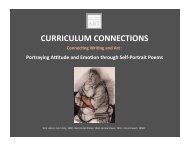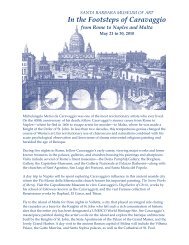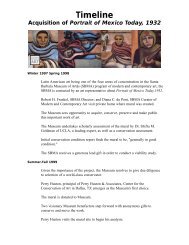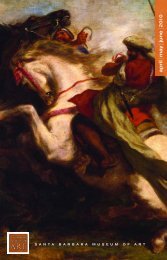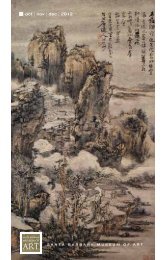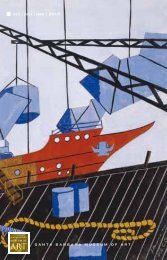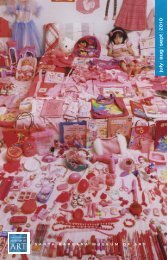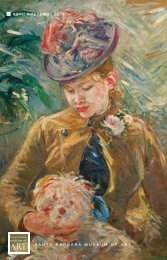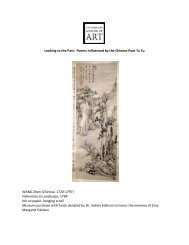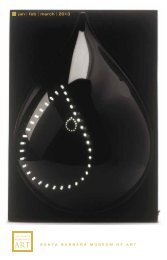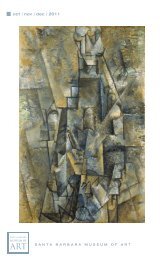Katsushika Hokusai and Henri Rivière
Katsushika Hokusai and Henri Rivière
Katsushika Hokusai and Henri Rivière
You also want an ePaper? Increase the reach of your titles
YUMPU automatically turns print PDFs into web optimized ePapers that Google loves.
<strong>Katsushika</strong><br />
<strong>Hokusai</strong><br />
<strong>and</strong><br />
<strong>Henri</strong> Rivière<br />
An<br />
Inspired<br />
Connection
Photographie du peintre <strong>Henri</strong> Rivière, Xavier Sébillot<br />
Japanese artist <strong>Hokusai</strong> <strong>and</strong> French artist <strong>Henri</strong> Rivière<br />
lived in very different places. Although they never met to<br />
talk about life, beauty, <strong>and</strong> art, they shared many<br />
connections.<br />
Self-Portrait, <strong>Hokusai</strong>
<strong>Hokusai</strong>’s artwork was an inspiration to <strong>Henri</strong> Rivière <strong>and</strong> many other European<br />
artists including Pierre Bonnard, Claude Monet, Mary Cassatt, <strong>and</strong> Vincent Van<br />
Gogh. They admired the bold designs, intense colors, <strong>and</strong> flat areas of pure<br />
color, as well as the elegant <strong>and</strong> simple lines of the Japanese prints.<br />
Vincent Van Gogh<br />
<strong>Hokusai</strong>
Can you find connections between the artwork<br />
of <strong>Hokusai</strong> <strong>and</strong> <strong>Henri</strong> Rivière? Look carefully at<br />
these two woodblock prints. How are they<br />
similar? What do they have in common?
Both of these artists were inspired by the beauty of the<br />
l<strong>and</strong>scape <strong>and</strong> the everyday life of ordinary people.<br />
They added interest to their woodblock prints by<br />
portraying the foreground, middle ground, <strong>and</strong><br />
background with varying proportions, <strong>and</strong> adding depth<br />
<strong>and</strong> perspective to the scenes they created.
It is easy to see how <strong>Hokusai</strong>’s<br />
artwork inspired Rivière, but the<br />
connection does not end there.<br />
Bridge <strong>and</strong> the Moon, <strong>Hokusai</strong> (detail)<br />
Both artists shared a passion<br />
for discovering beauty in the<br />
l<strong>and</strong>scape, including<br />
elements of nature that can<br />
be observed over <strong>and</strong> over<br />
– for example, the moon.<br />
How many times have you<br />
gone outside <strong>and</strong> looked up<br />
at the full moon, or noticed<br />
a slender crescent moon?<br />
The First Star at L<strong>and</strong>iris, <strong>Henri</strong> Rivière (detail)
<strong>Hokusai</strong> renders a full moon<br />
Yes, the full moon can be observed every month, but for both of these artists, each<br />
viewing was a unique experience. Was the night clear or foggy? Did clouds trail over the<br />
moon? Did it appear over a mountain, or over the tall buildings of a city? <strong>Hokusai</strong> <strong>and</strong><br />
Rivière experimented with the idea that the very same moon can appear to be both similar<br />
<strong>and</strong> different to viewers, depending on weather conditions, location, time, <strong>and</strong> season.<br />
Rivière captures a waning<br />
gibbous moon – can you find it<br />
in this woodblock print?
When he was in his sixties, <strong>Hokusai</strong> began to work on one of his most famous series of<br />
woodblock prints: the Thirty-six Views of Mount Fuji.<br />
South Wind, Clear Sky, <strong>Hokusai</strong><br />
Mount Fuji has traditionally been linked with eternal life. This belief can be traced to The<br />
Tale of the Bamboo Cutter, where a goddess deposits the elixir of life on the peak of this<br />
sacred mountain. To <strong>Hokusai</strong> <strong>and</strong> many others in Japan, Mount Fuji was the place to<br />
discover the secret of living forever.
In this image, the mountain predominates…
…<strong>and</strong> in this print, the most famous of the series, look where <strong>Hokusai</strong> positions the mountain.<br />
The focus is on the foreground, <strong>and</strong> the Great Wave threatens the men in the boats.<br />
The Great Wave, <strong>Hokusai</strong>
In all thirty-six prints, <strong>Hokusai</strong> captured not only the view of the mountain, but glimpses of everyday life.
<strong>Henri</strong> Rivière, who studied <strong>Hokusai</strong>’s process <strong>and</strong> prints, became inspired to create<br />
something new, influenced by the Japanese master. Rivière also chose a subject that was<br />
important to the people of his country – a source of both pride <strong>and</strong> wonderment.<br />
Instead of rendering a mountain, Rivière focused on thirty-six different views of a manmade<br />
monument that towered over the l<strong>and</strong>scape <strong>and</strong> cityscape of Paris.<br />
Do you recognize his subject?
Like Mount Fiji, the Eiffel Tower is<br />
one of the most recognizable, iconic<br />
images in the world. When they see<br />
the tower, people instantly think of<br />
PARIS!<br />
At the time this photograph was<br />
taken (1889), the Eiffel Tower was<br />
considered to be one of the greatest<br />
structures <strong>and</strong> symbols of the<br />
modern world.<br />
How could Rivière connect the style<br />
<strong>and</strong> sensibility of <strong>Hokusai</strong>’s natural<br />
l<strong>and</strong>scapes with his woodblock<br />
prints of this massive iron structure?
Frontispiece, from the Thirty-six Views of the Eiffel Tower, <strong>Henri</strong> Rivière<br />
Look again at this print. What do you notice? Is the tower in the foreground or the<br />
background? What other shapes predominate in this print? Like <strong>Hokusai</strong>, Rivière positions<br />
the main repeated element (the Eiffel Tower) in places where a Parisian citizen might look<br />
up <strong>and</strong> discover it. Perhaps through the leaves of a tree…
From the Place de la Concorde, Thirty-six Views of the Eiffel Tower, <strong>Henri</strong> Rivière<br />
..or even through the spray of a water fountain. His collection of woodcuts was a<br />
homage to <strong>Hokusai</strong>, the master who inspired him.
The Tower Under Construction, as seen from the Trocadero, <strong>Henri</strong> Rivière<br />
Like <strong>Hokusai</strong>, Rivière explored his subject<br />
from many different perspectives.<br />
A Worker in the Tower, <strong>Henri</strong> Riviére
<strong>Hokusai</strong> lived in ninety<br />
different houses during his<br />
long life.<br />
<strong>Henri</strong> Rivière divided his time<br />
between Paris (in the winter<br />
months) <strong>and</strong> his beloved<br />
summer cottage in rural<br />
Brittany. The natural beauty of<br />
the sea, sky, <strong>and</strong> l<strong>and</strong> inspired<br />
him to work on another series<br />
of prints, the Breton<br />
L<strong>and</strong>scapes.<br />
The First Star at L<strong>and</strong>iris, <strong>Henri</strong> Riviére
Loguivy, Evening, <strong>Henri</strong> Rivière
Rivière delighted in the rich<br />
colors, shapes, <strong>and</strong> textures of<br />
the l<strong>and</strong>scape that he never<br />
tired of viewing. Each hour of<br />
the day offered a different effect<br />
for the artist to capture,<br />
enhanced by light <strong>and</strong> shadow.<br />
Clouds could be white, orange,<br />
or purple, <strong>and</strong> the sea might be<br />
turquoise or deep Prussian blue.<br />
He found stories in the activities of<br />
his neighbors, <strong>and</strong> captured small<br />
moments in his prints.
Study of Waves: The Channel, <strong>Henri</strong> Rivière<br />
Look at the way Rivière created textures in the solid stone cliffs,<br />
<strong>and</strong> movement in the waves below. He learned these techniques from studying<br />
Japanese woodblock prints.
<strong>Hokusai</strong> wrote:<br />
When I was 50, I had published a universe of<br />
designs. But all I have done before the the<br />
age of 70 is not worth bothering with. At 75<br />
I'll have learned something of the pattern of<br />
nature, of animals, of plants, of trees, birds,<br />
fish <strong>and</strong> insects. When I am 80 you will see<br />
real progress. At 90 I shall have cut my way<br />
deeply into the mystery of life itself. At 100, I<br />
shall be a marvelous artist. At 110, everything<br />
I create; a dot, a line, will jump to life as<br />
never before. To all of you who are going to<br />
live as long as I do, I promise to keep my<br />
word. I am writing this in my old age. I used<br />
to call myself <strong>Hokusai</strong>, but today I sign my<br />
self 'The Old Man Mad About Drawing.”<br />
<strong>Hokusai</strong> lived to be 89 years old, <strong>and</strong> he<br />
never stopped creating art.<br />
Self-Portrait, <strong>Hokusai</strong>
<strong>Henri</strong> Rivière lived to be 87<br />
years old, <strong>and</strong> like <strong>Hokusai</strong>, he<br />
also continued to create art<br />
until he died. He lived the life of<br />
an artist – all of his early<br />
experiences influenced his later<br />
work.
As a young man in his early twenties,<br />
Rivière frequented a Parisian cabaret<br />
called The Black Cat Café (Chat Noir).<br />
In addition to working on a weekly<br />
edition of the Chat Noir journal, he<br />
created a form of shadow theater.
Rivière placed the silhouettes of figures, animals, <strong>and</strong> l<strong>and</strong>scape elements within a<br />
wooden framework at three different distances from the screen: the closest created<br />
the darkest (black) silhouette, <strong>and</strong> the next two created gradations of black to gray.<br />
Look at this woodblock print.<br />
Does it remind you of the effect Rivière created in his shadow plays?<br />
Moonlight (Clairs de lune), 1896, <strong>Henri</strong> Riviere
From youth to old age, both <strong>Hokusai</strong> <strong>and</strong> Rivière engaged in a process that began<br />
with inspiration, <strong>and</strong> included experimentation, self-expression, refinement,<br />
revision, <strong>and</strong> reflection.<br />
Now it is your turn to participate in that same process.<br />
We invite you to create a print of a natural l<strong>and</strong>scape yourself,<br />
inspired by the work of <strong>Hokusai</strong> <strong>and</strong> <strong>Henri</strong> Rivière.
Credits <strong>and</strong> Permissions:<br />
This presentation was created by SBMA for instructional use only <strong>and</strong><br />
is not to be altered in any way, or reproduced without attribution.<br />
For further information about these or other SBMA Education <strong>and</strong><br />
Outreach Programs, contact rkrieps@sbma.net



